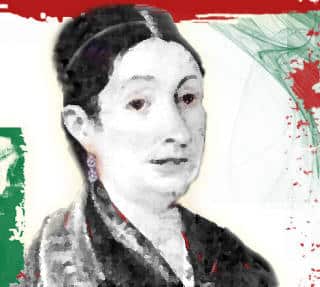Doña Josefa Ortiz de Dominguez, a Mexican patriot as well as a heroine of Mexico’s Independence War, made her name in history for her bravery when she risked her own life alerting the rebel insurgents about the discovery of the Queretaro Conspiracy for Independence.
Thanks to her, Father Miguel Hidalgo moved forward the date in which the Independence movement would start to the early hours of September 16th, 1810. Without her timely notice, the struggle for independence would have been discovered and the efforts of the conspirators would never have achieved their ultimate purpose: Mexico’s Independence from the Spanish Crown.
Maria de la Natividad Giron Josefa Ortiz is best known as Doña Josefa Ortiz de Dominguez, “La Corregidora” (the Chief Magistrate) of Queretaro. She was the daughter of the Spaniards Juan Jose Ortiz and Maria Manuela Giron.
She was born in Valladolid– what is now Morelia– in 1768 and was raised in Mexico City. Her parents died when she was a small child so her older sister Maria Sotero was granted custody. Maria enrolled her sister in the Colegio de las Vizcaínas, a very prestigious school to which she was accepted because she was a criolla, creole, that is, the children of Spaniards born in the New Spain.
While still a college student she met Miguel Dominguez, a widower who often visited the school. They fell in love and were married secretly in 1791; they had 14 children.
As secretary of the Royal Court, Miguel Dominguez was subsequently appointed magistrate of Queretaro in 1802 where the family settled. They quickly won over the sympathy of the Queretaro society of the time, joining various social groups.
It is well known that Doña Josefa was vehemently against the abuse that the Spaniards– that is, the European-born Spaniards – exercised over the natives considering and treating them as second-class citizens. She always identified with the native’s social problems, for they were relegated to secondary positions in public administration as well as in the military.
Throughout her life she fought for the recognition of the Indigenous people’s rights, in addition to using her position as Chief Magistrate to involve herself in numerous charitable ventures.
La Corregidora of Querétaro was a key figure at the very beginning of the struggle for independence. She actively participated in the Querétaro conspiracy, an underground movement that in essence gave way to the armed struggle for independence from the Spanish rule.
Its main objective was to establish a governing board to assume power and thus, she opened the doors of her house to hold so-called literary social gatherings, which were in fact, meetings of a political nature where decisions were made to initiate the independence movement.
These meetings were also attended by some of the most important revolutionaries that participated in the first stages of the struggle such as Don Miguel Hidalgo, Igancio Allende, Juan Aldama
The best known passage in the life of Doña Josefa Ortiz was when – on September 13, 1810– it was discovered that the supporters of the revolutionary movement were stockpiling weapons in their homes. The Chief magistrate, Doña Josefa’s husband, was immediately informed and ordered to raid the homes and the rioters jailed.
The Corregidor, Miguel Dominguez, aware of the clandestine meetings in which his wife participated, decided to warn her of the plot’s discovery and in order to protect her, also decided to lock her in her bedroom, for he well knew that she was very determined and that she would immediately give notice to her friends.
Doña Josefa was not one to be restrained or intimidated, so she wrote a note made from newspaper clippings, so that her handwriting could not be identified. She loudly stomped her heels on the floor of her room to draw attention, and was thus able to give the missive to the mayor, Ignacio Perez, who in turn sent it to FatherMiguel Hidalgo.
Upon receiving the note, Father Miguel Hidalgo decided to advance the date of the insurgency to the morning of September 16, 1810, instead of as previously planned – for the 1st of October of that year.
The priest summoned the faithful to fight for a more just government in what is now known as El Grito de Dolores. Hidalgo‘s call was successful, for most of those who joined the struggle were victims of the terrible conditions of life and of tremendous social inequalities.
Thanks to La Corregidora’s timely alert, many conspirators were able to escape before being arrested and jailed, though she herself was the victim of Captain Arias’ betrayal, on 14 September. She was arrested and taken to Mexico City, where a trial was held in which she was convicted of treason. She was jailed in various convents until finally, in June of 1817, her husband was able to have her released.
Once Independence from the Spanish rule was achieved, Agustin Iturbide – who proclaimed himself emperor – invited her to be part of his court, but she refused the appointment of Doña Josefa to the empress, because she considered that the Empire was completely contrary to the ideals for which the War of Independence had been fought. Moreover, she refused any reward for her services to the insurrection.
Doña Josefa Ortiz de Dominguez died on March 2, 1829 at the age of 61 in Mexico City. Her remains were moved to the city of Queretaro and deposited, along with her husband’s, in the Mausoleum of the Illustriousin Queretaro.
Chela Orozco


